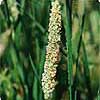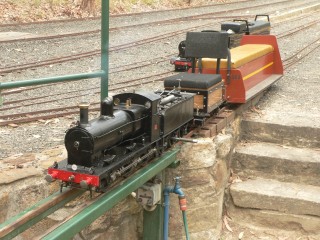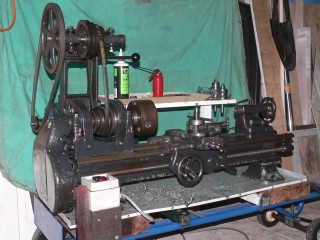 |
Test Notice Board |
 |
2012-11-23 - Live steam locomotive
After some work on my part and lots of favours from nice people I managed to get this little locomotive running and then bought it. Finished in 1978 it ran for a few years and has been kept inside ever since. Luckily it had been cleaned and well oiled before its life as a mantelpiece ornament. Now it's got a boiler ticket and has run a few times. The report describes the change to a running locomotive. The driver's carriage (aka bum truck) immediately behind was another simple effort that turned out much more work than was expected and the report shows its evolution. 2010-08-20 - Hercus lathe alive and well
It's taken far too long but Mr Busy (aka Steven Lazy aka me) has finally got the ancient Hercus lathe assembled and running. Made in 1946 it just missed the Second World War and has survived a life in the public service and then a dormant period in suburbia. The report shows recent pictures and the changes I've done to made it more suitable for a non-machinist like myself. It's a lovely old toy except that it isn't house-trained and drips oil everywhere.
2008-03-13 - Learning stick welding (not a relaxing pastime)Late last year I needed to weld some components so I decided to have another try at stick welding. Two months later I'm still muddling along and slowly learning how to drive the infernal welder and produce a useful result. This certainly isn't a quick and easy skill to learn but it is good when things work. Some useful sources of info are this welding forum and the sci.engr.joining.welding newsgroup (which one can access via google groups if one isn't setup for Usenet access). With resources like these it is possible (just) to learn welding via the Internet. I also found a couple of good books at the local library. I had trouble holding the electrode accurately enough (probably lousy co-ordination or too much caffeine) particularly when using small rods and doing tiny welds. So I made a lightweight holder with a two metre cable that connects to the standard holder. Even with this holder I still hold the rod when it is full length. The latest version of this holder is shown here and consists of a 12mm length of 12mm brass rod and a 63mm length of 8mm thin-walled tube. The cable connects to the back of the brass rod (the brass rod has a reduced section to fit inside the tube and this section is bored for the cable end). The tube is covered with PVC tube as this is the handle. The cable is Jaycar speaker cable rated at 60 amps but I run it at up to 100 amps and nothing has even got warm so far. The thin-walled tube at each end of the cable is K&S brass tube from a hobby shop. The holder will accept rods up to 2.6mm dia. Anyway, I'm totally addicted to this holder. Also, I'm now using Gemini type 12 rods which seem great to me. Bob the Welder is my current source for these rods and other bits and he runs a good online shop. This is great for me as there aren't any good welding supply shops locally and the online prices are better than I can get here. At first I thought that stick welding was a frantic pig of a process compared to gas (OA) welding. My opinions now are very different because stick welding is so much more versatile than gas. It's still not what I would call pleasant but it sure is useful and effective. Now I've bought an inverter welder. It's only a Chinese cheapie so it won't impress any of the professionals but it does work and is good value to me. There is a report on this new toy with my initial impressions. 2007-12-19 - CQ9325 lathe review now available
After the trials and tribulations of buying a lathe recently I have written a review on this new toy. The report contains details of the lathe and many images showing it together and in pieces during its preparation stage. It is a cheap Chinese lathe and required a fair amount of work to correct problems mainly due to lousy machining. The end result isn't pretty but it now works properly and should have a happy life shredding pieces of metal as I learn how to use it.
2006-07-11 - New Notice Board facilityWelcome to the new notice board facility. This is being developed in anticipation of some reportable news and an audience. It was first written so a site owner could make limited changes to a website being developed by another party. The entered text is HTML but the small set of tags required here is easy to learn. This provides a very flexible update facility simple enough for novice users and powerful enough for proficient users. The system here consists of two Perl/CGI pages and four data files. The board.cgi page (styled by board.css) displays the notice board and the entry.cgi page is for text editing. The text is stored in board.txt. The alternative text file is draft.txt and this can be used to store changes without affecting the published text file (board.txt). The entry page can read from both the board.txt file and the draft.txt file and save the displayed text to either file. The entry page also contains a preview section where the edited text can be viewed before being saved. The entry page requires a username and password before any text can be accessed or changed. The scripts are written in Perl rather than PHP so the files are created with the site owner UID rather than the common UID that PHP uses. This makes it harder for other users to attack the text files. This difference relies on Apache having suExec enabled and setup to run cgi scripts using the site UID. An alternative display page called board.shtml can also be used. This uses SSI to include the text file rather than being a Perl script. The relevant portion of this page can be included in other pages to provide a customised notice board. In summary :
For more adventurous or troublesome folk there is also a 'C++' version of both board.cgi and entry.cgi. These should be faster as they don't have to be compiled/interpreted each time the page is requested. But there doesn't seem to provide any performance improvement and they certainly were harder to write than the Perl versions. At best, they might be interesting but probably not a good idea. Having said this, I have to admit that I am currently using the C++ versions. Regards - Steven - (real e-mail address is on home page)2006-08-11 - Ancilliary program now availableTo facilitate adding images to web pages (e.g. this notice board) a Win32 program that resizes and uploads images is now available. The program accepts the input file name and required width and then creates a scaled copy and uploads this to the server. This program is described in the Pickup page and this page contains a download link. The download file is an install package created by Inno Setup 5.1.6 (excellent freeware).
2006-07-27 - Test using images and floats and a table
------------ top ------------ |
||||||||||||||||||||||||||||||||||||||||||||||||||||||||||||||||||||||||||||||||
